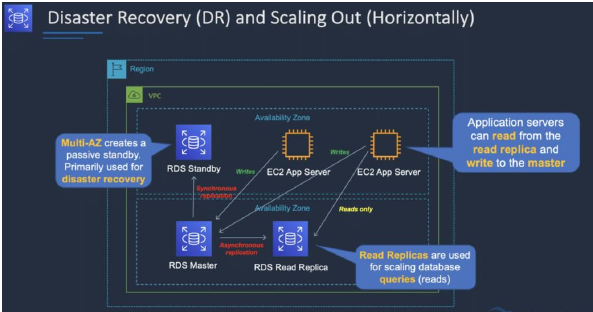
Amazon Relational Database Service (Amazon RDS) is a managed service that makes it easy to set up, operate, and scale a relational database in the cloud.
Relational databases are known as Structured Query Language (SQL) databases.
Non-relational databases are known as NoSQL databases.
RDS is an Online Transaction Processing (OLTP) type of database. RDS features and benefits:
- SQL type of database.
- Can be used to perform complex queries and joins.
- Easy to setup, highly available, fault tolerant, and scalable.
- Used when data is clearly defined.
- Common use cases include online stores and banking systems.
Amazon RDS supports the following database engines:
- SQL Server.
- Oracle.
- MySQL Server.
- PostgreSQL
- Aurora
- MariaDB.
Aurora is Amazon’s proprietary database. RDS is a fully managed service and you do not have access to the underlying EC2 instance (no root access).
The RDS service includes the following:
- Security and patching of the DB instances.
- Automated backup for the DB instances.
- Software updates for the DB engine.
- Easy scaling for storage and compute.
- Multi-AZ option with synchronous replication.
- Automatic failover for Multi-AZ option.
- Read replicas option for read heavy workloads.
A DB instance is a database environment in the cloud with the compute and storage resources you specify.
Encryption:
- You can encrypt your Amazon RDS instances and snapshots at rest by enabling the encryption option for your Amazon RDS DB instance.
- Encryption at rest is supported for all DB types and uses AWS KMS.
- You cannot encrypt an existing DB, you need to create a snapshot, copy it, encrypt the copy, then build an encrypted DB from the snapshot.
DB Subnet Groups:
- A DB subnet group is a collection of subnets (typically private) that you create in a AWS virtual private cloud (VPC) and that you then designate for your DB instances.
- Each DB subnet group should have subnets in at least two Availability Zones in each region.
- It is recommended to configure a subnet group with subnets in each AZ (even for standalone instances).
AWS Charge for:
- DB instance hours (partial hours are charged as full hours).
- Storage GB/month.
- I/O requests/month – for magnetic storage.
- Provisioned IOPS/month – for RDS provisioned IOPS SSD.
- Egress data transfer.
- Backup storage (DB backups and manual snapshots).
Scalability:
- You can only scale RDS up (compute and storage).
- You cannot decrease the allocated storage for an RDS instance.
- You can scale storage and change the storage type for all DB engines except MS SQL.
RDS provides multi-AZ for disaster recovery which provides fault tolerance across availability zones:
- Multi-AZ RDS creates a replica in another AZ and synchronously replicates to it (DR only).
- There is an option to choose multi-AZ during the launch wizard.
- AWS recommends the use of provisioned IOPS storage for multi-AZ RDS DB instances.
- Each AZ runs on its own physically distinct, independent infrastructure, and is engineered to be highly reliable.
- You cannot choose which AZ in the region will be chosen to create the standby DB instance.
Read Replicas – provide improved performance for reads:
- Read replicas are used for read heavy DBs and replication is asynchronous.
- Read replicas are for workload sharing and offloading.
- Read replicas provide read-only DR.
- Read replicas are created from a snapshot of the master instance.
- Must have automated backups enabled on the primary (retention period > 0).
Pricing
Amazon Relational Database Service (RDS) Pricing RDS pricing is determined by:
- Clock hours of server uptime – amount of time the DB instance is running.
- Database characteristics – e.g. database engine, size, and memory class.
- Database purchase type – e.g. On-Demand, Reserved.
- Number of database instances.
- Provisioned storage – backup is included up to 100% of the size of the DB. After the DB is terminated backup storage is charged per GB per month.
- Additional storage – the amount of storage in addition to the provisioned storage is charged per GB per month.
- Requests – the number of input and output requests to the DB.
- Deployment type – single AZ or multi-AZ.
- Data transfer – inbound is free, outbound data transfer costs are tiered.
- Reserved Instances – RDS RIs can be purchased with No Upfront, Partial Upfront, or All Upfront terms. Available for Aurora, MySQL, MariaDB, Oracle and SQL Server.